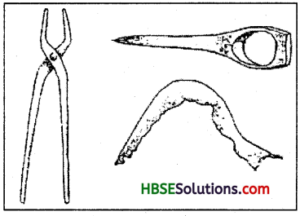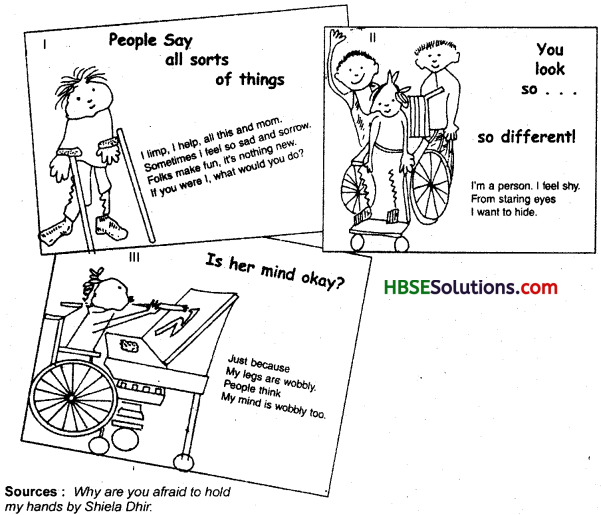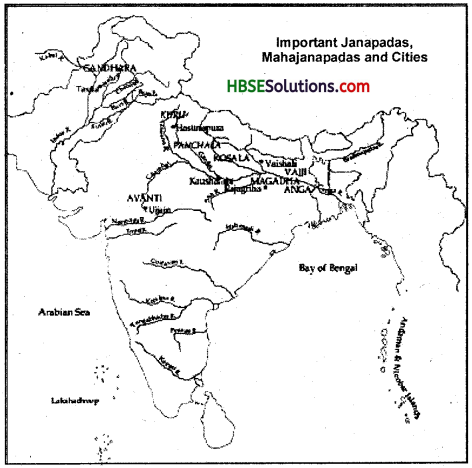HBSE 6th Class Social Science Solutions History Chapter 9 Vital Villages, Thriving Towns
Haryana State Board HBSE 6th Class Social Science Solutions History Chapter 9 Vital Villages, Thriving Towns Textbook Exercise Questions and Answers.
Haryana Board 6th Class Social Science Solutions History Chapter 9 Vital Villages, Thriving Towns
HBSE 6th Class History Vital Villages, Thriving Towns Textbook Questions and Answers
Vital Villages Thriving Towns Class 6 Notes HBSE Question 1.
Fill in the blanks:
- ________ was a word used for large landowners in Tamil.
- The grama-bhojaka often got his land cultivated by the ________.
- Ploughmen were known as ________ in Tamil.
- Most grihapatis were ________ landowners.
Answer:
- Vellalar
- Slaves/hired labourers
- Uzhavar
- Smaller.
Class 6 History Chapter 9 Question Answer HBSE Question 2.
Describe the functions of the Grama-Bhojaka. Why do you think he was powerful?
Answer:
Functions of the Grama-Bhojaka:
The village headman was known as grama- bhojaka and he was the largest land-owner. He had slaves or hired workers to cultivate his land.
- The king often used him to collect taxes from the village.
- He also functioned as a judge and also as a policeman.
He was powerful because :
- he had a close association with the king.
- he had a strong control over the village.
- he had the largest land which means he was quite rich and hence had financial power.
![]()
Class 6th History Chapter 9 HBSE Vital Villages, Thriving Towns Question 3.
List the crafts person who would have been present in both villages and cities.
Answer:
Carpenters, weavers, potters, black-smiths, goldsmiths etc.
Question 4.
Choose the correct answer:
(а) Ring wells were used for:
1. bathing
2. washing clothes
3. irrigation
4. drainage.
Answer:
4. drainage.
(b) Punch marked coins were made of:
1. silver
2. gold
3. tin
4. ivory.
Answer:
1. silver
(c) Mathura was an important:
1. village
2. port
3. religious centre
4. forested area.
Answer:
3. religious centre
(d) Shrenis were associations of:
1. rulers
2. craftspersons
3. farmers
4. herders.
Answer:
2. craftspersons
Let’s discuss
Question 5.
Which of the iron tool shown on page 87 your NCERT Text Book would have been important for agriculture? What would the other tools have been used for?

Answer:
Ploughshares would have been important for agriculture. The other tools used were sickles and axes. The other tools like tongs, nails and hammers were used for carpentry and also by ironsmiths.
![]()
Question 6.
Compare the drainage system in your locality with that of the cities mentioned in the lesson.
Answer:
Similarities:
- Both the cities and our localities have a good drainage system in each house.
- Even today, there is hardly any cleanlines and people use them carelessely. People in ancient times used them as drains, garbage dumps and even as toilets.
Differences:
Today drainage system has been systematically planned as compared to ancient times.
Let’s Do
Question 7.
If you have seen crafts persons at work, describe what they do in a short paragraph. (Hint : how do they get the raw materials, what kind of equipment do they use, how do they work, what happens to the finished products)
Answer:
- The craftsperson buys raw material from different parts of the city or the village.
- He works in a part of the house, with the help of the family members.
- He works with simple tools like looms, spindles and needles.
- The finished product is sent either to the cities for selling or the merchants come to the houses of the craftsperson to buy goods.
Question 8.
List the functions performed by men and women who live in your city or village. In what ways are these similar to those performed by the people who lived in Mathura? In what ways are they different?
Answer:
Similarities : The people in Mathura worked as goldsmiths, blacksmiths, weavers, basket makers, garland makers, perfumers. In present times, people in cities are goldsmiths and others are present in the villages.
Differences: In present times, we can find people who work in offices, banks, schools, colleges, etc., but they were not present in those days.
HBSE 6th Class History Vital Villages, Thriving Towns Important Questions and Answers
Very Short Answer Type Questions
Question 1.
What were the Jataka tales?
Answer:
Jataka tales were the stories that were probably composed by ordinary people and then written down and preserved by Buddhist monks.
Question 2.
Why do the kings demand taxes from farmers or revenues? How does it also benefit the farmers?
Answer:
The kings demand taxes as they need money for armies, palaces and forts. Since for increasing production. The king provides money and plans irrigation works and also the labour is provided by people, the probability of quality production increases.
Question 3.
Bring out the division in Tamil region in the agricultural sector.
Answer:
Vellalar
(large landowners)
↓
Uzhavar
0ordinary ploughmen)
↓ ↓
Kadaisiyar adimadi
(slaves) (slave)
Question 4.
Who were grihapatis?
Answer:
Grihapatis were independent farmers with smaller lands.
![]()
Question 5.
Who were dasa Karamkaras?
Answer:
Dasa karamkaras were people who did not own land and had to earn a living working on the field owned by others.
Question 6.
What are punch marked coins?
Answer:
Punch marked coins have been given this name because the designs were punched on to the metal-silver or copper. Archaeologists have found thousands of these coins. They were in use about 500 years back.
Short Answer Type Questions
Question 1.
How can we find about the life of the people in early times? (Give three evidences)
Answer:
We can find more about the life of the people in early times from:
- Archaeological evidences, i.e., things found after digging certain sites and old historical buildings.
- From tales of the early people and other literary sources.
- From sculptures: Sculptors carved scenes depicting people’s lives in towns and villages, as well as in the forest. Many of. these sculptors were used for decorating railings, pillars and gateways of buildings.
Question 2.
What are ring wells and their functions?
Answer:
In many cities, archaeologists have found rows of pots or ceramic rings arranged one top of the other. These are known as ring wells. They function as :
- toilets
- arains
- garbage dumps.
Question 3.
Why can’t much be explored about common people’s lives?
Answer:
- There are hardly any remains of places, markets or of homes of ordinary people.
- Some are yet to be discovered by archaeologists.
- Others made of wood, mudbrick and thatch may not have survived.
Question 4.
How do travellers play an important role in finding about cities?
Answer:
- One way of finding about cities is from the accounts of sailors and traveller who visited them.
- One of the most detailed accounts has been given by an unknown Greek sailor. He described all potas he visited.
Question 5.
Give reason :
(a) Mathura emerged and has been an important settlement for more than 2500 years.
OR
How can we say that Mathura is multi-functional town?
Answer:
It was important because it was located at the cross roads of two major routes of travel and trade – from the northwest to the east and from north to south. There were fortifications around the city, and several shines. Farmers and herders from adjoining areas provided food for people in the city. Mathura was also a centre where some extremely fine sculpture was produced.
![]()
Question 6.
Give evidence that Mathura was a religious centre.
Answer:
Mathura was a religious site as:
- There were Buddhist monastries.
- Jaina shrines.
- It is an important centre for Krishna.
Question 7.
What archaeological evidences give us insights into the town of Mathura?
Answer:
Several inscriptions on surface such as stone slabs and statues have been found in Mathura. Generally, these are short inscriptions, recording gifts made by men (and sometimes women) to monasteries and shrines. These were made by kings and queens, officers, merchants and crafts persons who lived in the city. For instance, inscriptions from Mathura mention goldsmiths, blacksmiths, weavers, basket ; markers, garland makers, perfumers.
Question 8.
Besides the use of coins, what were the other methods to buy and sell goods? How do we know about it?
Answer:
The merchants exchanged their goods , with the goods of other merchants. We come to know about this method of exchange from a poem in the Sangam literature. The poem mentions the exchange of paddy and salt.
Question 9.
What were shrenis? How did they function?
Answer:
Many craftspersons and merchants formed associations known as shrenis. They provided training, procured raw material and distributed the finished goods. The shrenis of the merchants organised the trade. Shrenis also served as banks, where rich men and women deposited money. This was invested and part of the interest was returned or used to support religious institutions and monasteries.
Long Answer Type Questions
Question 1.
What are shrenis? What are its functions many craftspersons and merchants now formed associations known as Shrenis.
Answer:
- These Shrenis of craftspersons provided training procured raw material and distributes the finished products.
- The Shrenis of merchants organised the trade.
- Shrenis also served as banks where rich men and women deposited money.
This was invested and part of the interest was returned or used to support religious institutions such as monastries.
Question 2.
What are the findings in Arikamedu?
OR
Write a short note on Arikamedu.
Answer:
Arikamedu was a coastal settlement where ships unloaded goods from distant lands. A massive brick structure, which may have been a warehouse, was found at the site. Other finds include pottery from the Mediterranean region, such as amphorae (tall double-handled jars contained liquids such as wine or oil) and stamped red-glazed pottery, known as Arretine Ware, which was named after a city in Italy. This was made by pressing wet clay into a stamped mould. There was yet another kind of pottery which was made locally, though Roman designs were used. Roman lamps, glassware and gems have also been found at the site. Small tanks have been found that were probably dyeing vats, used to dye cloth. There is plenty of evidence for the making of beads from semi-precious stones and glass.
![]()
Question 3.
How do we learn about the city of Bharuch ? Write about the port city.
Answer:
A Greek sailor has left a detailed account about all the ports that he visited. He wrote about the city of Bharuch, which he called Barygaza. He mentions :
- The gulf was very narrow at Barygaza and was very hard to navigate for those coming from the sea.
- Ships had to be steered in by skilful and experienced local fisherman, who were employed by the king.
- The main imports at Barygaza were wine, copper, tin, lead, coral, topaz, cloth, gold and silver coins.
- The main exports were plants from the Himalayas, ivory, agate, cotton, silk and perfumes.
- Special gifts were brought by the merchants for the king, which included vessels of silver, fine wines and fine cloth.
The two things that were not in use during Harappan times were wine and coral.
Vital Villages, Thriving Towns Class 6 HBSE Notes
- Shreni : A group of merchants and craftsmen following the same trade.
- Punch Marked Coins: Coins that were punched by the government. They were crude in shape and made of copper.
- Sangam : An assembly or gathering of literary persons.
- Satraps : They were the military commander under Sakas.
- Ring-Well: Rows of pots or ceramic rings arranged one on the top of the others, is known as ring-well.
- Vellalar : They were big land owners in Tamil Nadu.
- Kadaisiyar and Adimai : Landless labourers which also includes slaves were called Kadaisiyar and adimai in Tamil region.
- Grama-bhojaka : In northern part of India, the headman of the village is known by the name of Grama-bhojaka.
- Dakshinapatha : Route towards south.
- Irrigation : To water the crops by means of canals, wells or tanks.
HBSE 6th Class Social Science Solutions History Chapter 9 Vital Villages, Thriving Towns Read More »




